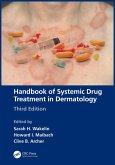Cutaneous Drug Eruptions: Diagnosis, Histopathology and Therapy is an accessible resource for early detection and resolution of cutaneous drug reactions. It provides dermatologists, primary care physicians and all medical personnel with access to comprehensive and practical clinical information that will help them identify and appropriately manage all incidences of skin conditions and disease that relate to the use of drugs.
Dieser Download kann aus rechtlichen Gründen nur mit Rechnungsadresse in A, B, BG, CY, CZ, D, DK, EW, E, FIN, F, GR, HR, H, IRL, I, LT, L, LR, M, NL, PL, P, R, S, SLO, SK ausgeliefert werden.
"This book discusses the underlying immunopathology and histology responsible for the patterns of drug rashes. ... The audience is dermatologists and primary care physicians. ... The authors do an outstanding job of helping track down the villainous drug. If you are interested in honing your Sherlock Holmes diagnostic skills, get this book. I plan to keep it close by." (Patricia Wong, Doody's Book Reviews, November, 2015)









